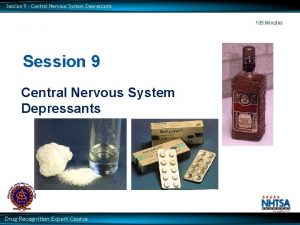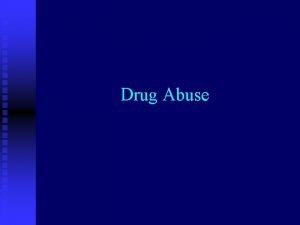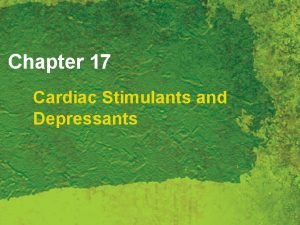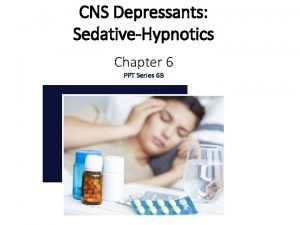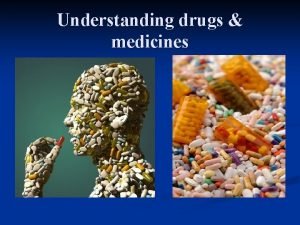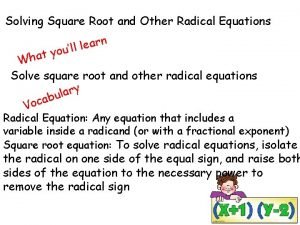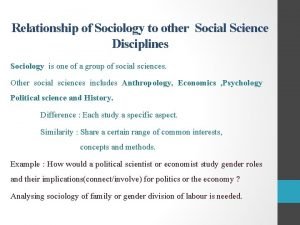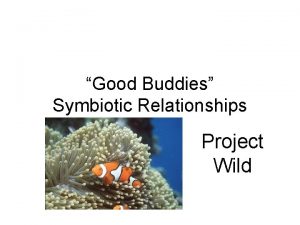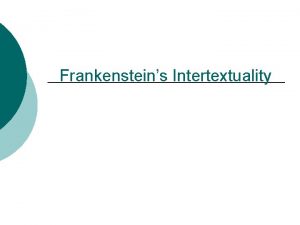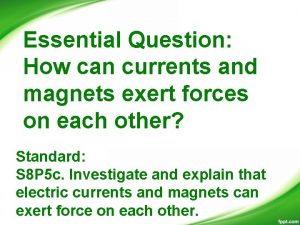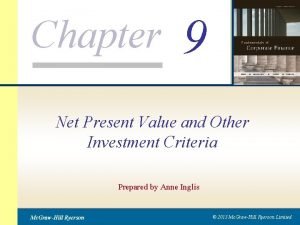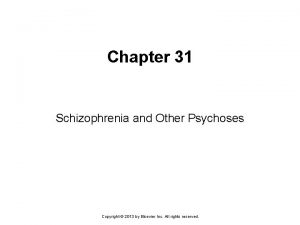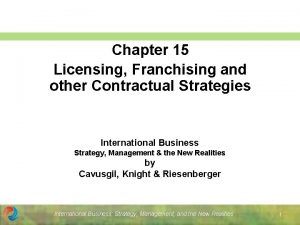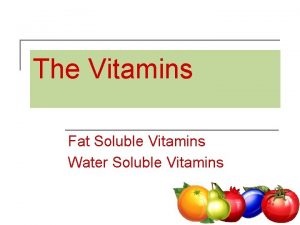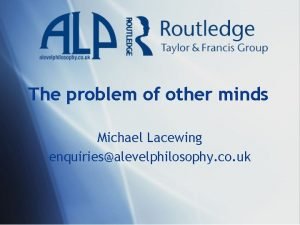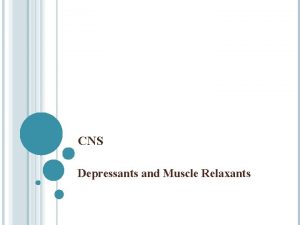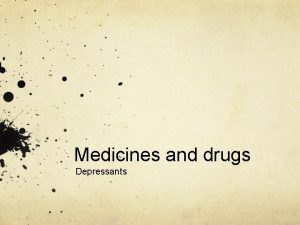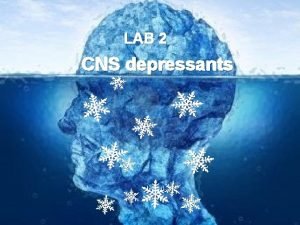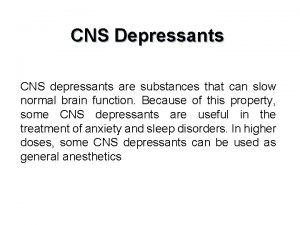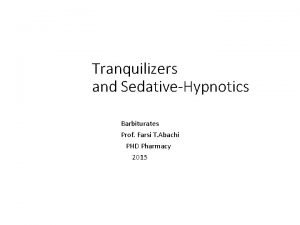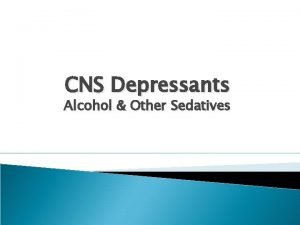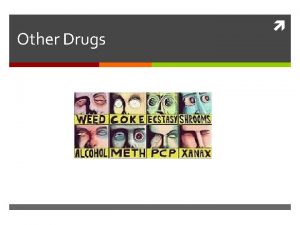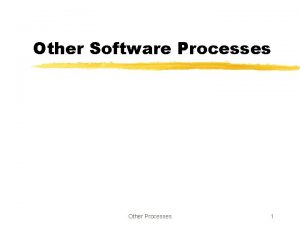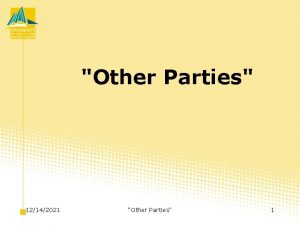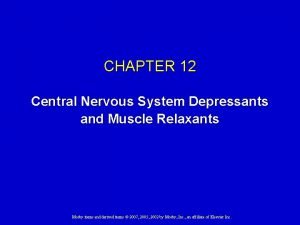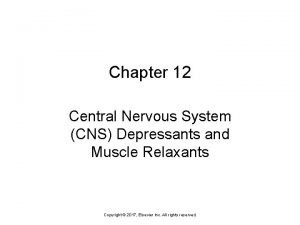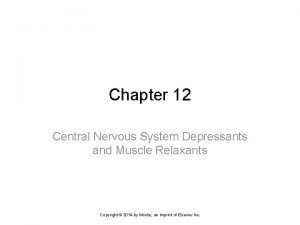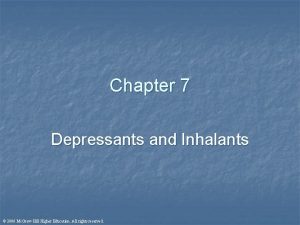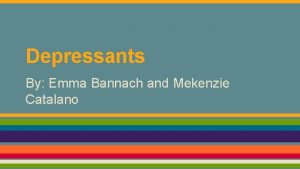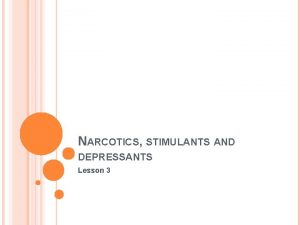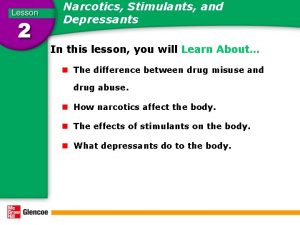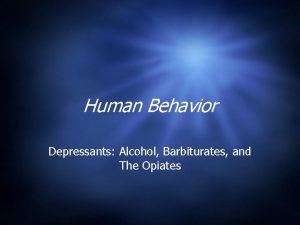Tranquilizers and other depressants n n n DEPRESSANTS


























- Slides: 26

Tranquilizers and other depressants n n n DEPRESSANTS are drugs that slow down the normal activity of the brain and spinal cord. Examples are ALCOHOL, barbiturates, and benzodiazepines, such as VALIUM and XANAX. Although a “club drug, ” ROHYPNOL falls in the benzodiazepine class. TRANQUILIZERS slow brain activity through actions on the GABA system. Gamma-amino butyric acid is a neurotransmitter that acts as a natural tranquilizer. NEUROTRANSMITTERS are chemicals that deliver messages from one nerve cell to the other. Small amounts of TRANQUILIZERS or DEPRESSANTS produce feelings of calmness, drowsiness, and RELAX muscles as well as symptoms similar to DRUNKENNESS. Since depressants reduce REM sleep, users who try to “kick the habit” after even a few days of depressant use may suffer from NIGHTMARES or INSOMNIA.

Alcohol n n Alcohol belongs to a class of drugs called DEPRESSANTS. The SPEED of consumption, the type of BEVERAGE consumed, a person’s BODY weight and GENDER, and the amount of food eaten have an impact on how a person will react to alcohol. JUDGMENT is the first function of the brain to be affected. DRINKING too much can cause lethargy, confusion, LOSS of motor control, amnesia, depressed BREATHING, and even UNCONSCIOUSNESS.

Alcohol cont. n n n Signs of INTOXICATION include slurred speech; stumbling or having difficulty maintaining balance and walking independently; trouble making eye contact, feeling excessively COLD or WARM; shortness of BREATH; erratic, withdrawn, or aggressive behavior; queasiness, or VOMITING; even unconsciousness. Alcoholics often suffer from DENIAL, deciding not to recognize a problem as a problem. BINGE drinking is drinking to get drunk. It can result in alcohol poisoining, which can make you very ill or even kill you.

Recent Stats: You do the Math. The 2011 Youth Risk Behavior Survey found that among high school students, during the past 30 days n 39% drank some amount of alcohol. n 22% binge drank. n 8% drove after drinking alcohol. n 24% rode with a driver who had been drinking alcohol.

Youth who drink alcohol are more likely to experience n School problems, such as higher absence and poor or failing grades. n Social problems, such as fighting and lack of participation in youth activities. n Legal problems, such as arrest for driving or physically hurting someone while drunk. n Physical problems, such as hangovers or illnesses. n Unwanted, unplanned, and unprotected sexual activity. n Disruption of normal growth and sexual development. n Physical and sexual assault. n Higher risk for suicide and homicide. n Alcohol-related car crashes and other unintentional injuries, such as burns, falls, and drowning. n Memory problems. n Abuse of other drugs. n Changes in brain development that may have life-long effects. n Death from alcohol poisoning. Still think it’s appealing? Talk to an alcoholic who tried to stop.

Do drugs affect our consciousness? n n YES! They “alter” our consciousness. They cause addiction, which means our bodies crave them to feel normal. They change our moods, alter our perceptions, and cause us to see things that are not real. This is true of BOTH legal and illegal drugs!

Hallucinogens n n Hallucinogens are PSYCHEDELICS, a diverse group of illegal drugs that affect a person’s perceptions, sensations, thinking, self-awareness, and emotions. Four different types of hallucinogens are marijuana, LSD, PEYOTE, and MUSHROOMS. LSD is an odorless, colorless, and tasteless chemical. Its nickname is ACID. Physical effects may include DILATED pupils, ELEVATED body temperature, sweating, INCREASED heart rate, confusion, suspicion, anxiety, and LOSS of control.

LSD slang What is a “bad trip? ” A SCARY INSTEAD OF PLEASANT TRIP What is a “flashback? ” GOING BACK TO A TIME WHEN YOU WERE TRIPPING

LSD in your spine? Current theory says LSD does not “STAY” in your spine, but people attribute it to “jerks” in their spine that cause flashbacks. Drugs like marijuana will stay in your system longer because they attach to your fatty tissue. Chronic use of LSD can result in persistent psychosis and hallucinogen persisting perception disorder (HPPD). However, all of these conditions are now considered to be psychological phenomena and not actually because of drug residue. Doctors are not certain what causes the flashbacks that are attributed to LSD remaining in the spinal fluid, but they agree that LSD users have them.

Marijuana: What You Need to Know Ø Ø Ø ALL forms of marijuana are mind-altering (psychoactive). In other words, they change how the brain works. Marijuana contains more than 400 chemicals, including THC, the main active ingredient. THC levels are steadily increasing. Today’s marijuana is not the marijuana of your parents’ generation. It is MUCH stronger and psychologically addictive. In general, standard urine tests can detect traces (metabolites) of THC several days after use. In heavy users, however, THC metabolites can sometimes be detected for weeks after use stops.

Marijuana: What You Need to Know Ø Ø Ø Long-term studies of drug use patterns show that few high school students use other illegal drugs without first trying marijuana, thus, its nickname as a “gateway” drug. Regular use of marijuana has also been associated with depression, anxiety, and amotivational syndrome, which means a loss of drive or ambition. Marijuana use impairs your immune system. Users' risk for a heart attack is four times higher than normal within the first hour after smoking marijuana. Its effects can be unpredictable, especially when mixed with other drugs. It is sometimes classed as a depressant, sometimes as a stimulant, and sometimes as a hallucinogen because it exhibits properties of all three. It is almost always classed as a hallucinogen.

Marijuana: What You Need to Know SHORT-TERM marijuana use causes: n problems with learning and memory; n distorted perception (sights, sounds, time, touch); n diminished motor coordination; and n increased heart rate. CHRONIC marijuana abuse may cause: n increased rates of anxiety, depression, and schizophrenia, n addiction, n heart attacks and respiratory problems, n and brain alterations such as changed thinking patterns or memory loss/malfunction.

Marijuana Fact: Marijuana and driving do not mix. It is the most common illegal drug found in drivers who die in accidents (around 14 percent of drivers), sometimes in combination with alcohol or other drugs.

Stimulants n n Stimulants increase the activity of the nervous system. They speed up the heart and breathing rates. Stimulants include caffeine, nicotine, meth, amphetamines, crack, and cocaine. YES, this is a book. YUCK!

Stimulants n n n n STIMULANTS are drugs that speed up your activity level, give you more ENERGY and curb your APPETITE. CAFFEINE is a stimulant found in a number of foods including coffee, tea, chocolate, and soft drinks. One of the most frightening stimulants is METHAMPHETAMINE, also known as “crank. ” Meth is SNORTED, INJECTED, or smoked. Side effects include increased HEART rate, blood PRESSURE, and BODY temperature. WITHDRAWAL symptoms include depression, anxiety, fatigue, paranoia, aggression, and an intense CRAVING for the drug. Meth addicts are the most DIFFICULT to treat because, over time, the drug destroys the user’s ability to experience PLEASURE. Many BRAIN cells lose their ability to function permanently.

Stimulants: Nicotine n n n n Most common stimulant Spurs the release of adrenaline Highly addictive Withdrawal symptoms include nervousness, drowsiness, insomnia, dizziness, sweating, etc. Serious health risks such as lung cancer, emphysema, and heart disease Secondhand smoke can be harmful to others around you. Smoking causes more deaths annually than car accidents.

Cocaine and Crack n n COCAINE is a highly addictive stimulant and one of the most widely abused illegal drugs in America. Cocaine comes from the COCA leaf, not the cacao plant where chocolate comes from. Cocaine is SNIFFED (snorted) or INJECTED; crack cocaine is SMOKED. Cocaine REDUCES appetite, makes the user feel more ALERT, energetic, and SELF-confident. It may produce a feeling of EUPHORIA and inhibit the need for SLEEP.

Cocaine and Crack cont. n n n Long-term cocaine use produces drug TOLERANCE and makes the cravings become OBSESSIVE. When users try to stop, they often experience what is commonly known as “crashing, ” which entails the onset of EXHAUSTION and depression. When an addict stops using cocaine, it may take TWO years or more before they can even experience pleasure from the little things in life.

Stimulants: Amphetamines n n n Known for helping people stay awake First used in WWII to keep soldiers awake Also known as “speed” or “uppers” Highs can last for days, but crashes often lead to depression, even suicide. Amphetamines also cause restlessness, insomnia, loss of appetite, and irritability. They may even cause delusions, like thinking you can fly without an airplane.

Club Drugs n n MDMA is also known as ECSTASY; it makes user more SENSITIVE to light, taste, touch, and smell. It also increases heart rate and blood pressure and DISABLES the body’s ability to regulate its own temperature. The user’s brain cannot release normal amounts of serotonin, causing DIFFICULTY sleeping, fatigue, achiness, and a MOOD crash. Ketamine is also known as “special K. ” It and another drug called PCP (“angel dust”) are either snorted or DISSOLVED in beverages. The user’s senses, judgment, memory, and coordination can be affected for up to THREE days after initial use of the drugs. Rohypnol and GHB are known as the “DATE RAPE” drugs because they cause BLACKOUTS or amnesia. Especially if mixed with ALCOHOL, these drugs can cause vomiting, coma, or even DEATH by respiratory failure.

Heroin n n Heroin comes from the OPIUM POPPY. It can be SNIFFED, SMOKED, or dissolved in water and INJECTED. Most doses are “CUT, ” which means they are diluted with other substances and not pure heroin. Heroin and other opiates belong to a class of drugs called NARCOTICS. Many have valuable medical uses such as NUMBING the senses, RELIEVING severe pain, and INDUCING sleep. Examples include CODEINE and HYDROCODONE (both found in prescription cough syrups), methadone, OXYCONTIN (so addictive it’s no longer sold @ retail pharmacies), or even opiates mixed with OTC painkillers, such as ACETIMINOPHEN (known by the brand name Percocet) or with ASPIRIN (known by the brand name Percodan). Opiates DEPRESS the activity of the nervous system, including REFLEXES such as coughing, breathing, and heart rate.

Anabolic Steroids n n n ANABOLIC STEROIDS are synthetic drugs used to enhance ATHLETIC performance, increase strength, BUILD muscle, and LOWER body fat. They are known as synthetic ANDROGENS, or male sex hormones. TESTOSTERONE is the principal one. They mimic natural testosterone and are abused by both genders. Steroids can cause VIOLENT aggression and violent behavior known as “ROID RAGE. ” The physical effects of steroid use are usually PERMANENT. Steroid users are usually banned from professional and amateur sports leagues.

Drug Abuse vs. ü ü ü Any use of an illicit substance is considered abuse. The user may not be motivated to continue use. It is considered misuse of a substance even if the substance is legal, like caffeine. ü ü Addiction Drug is necessary to function without withdrawal symptoms. Addiction is almost always psychological but can be physical as well. The motivation to continue use is extremely strong. It often becomes the driving force in a person’s life.

Drug Abuse vs. Drug Addiction n n Abused drugs are not always highly addictive drugs. Other factors are important in motivating drug use, for example, socialization. Ease of availability is an important determinant of drug use. Many prescription drugs are often abused mainly because of their widespread availability. In fact, prescription drugs are often referred to as "kiddie dope, " suggesting that these are not the preferred drugs of hard-core users.

Addiction n The drug's effects on the central nervous system (CNS) remain the primary determinants of drug addiction. “The normal controls on the individual's life have lost their significance and behavior focuses on procurement and selfadministration of the addictive substance. ” In other words, you don’t just WANT it; you NEED it. You believe you can’t survive without it, and you’ll do anything to get it.

Treatments for Drug Abuse The BEST treatment is to AVOID drugs. Others include: 1) Detoxification – removing the substance from the body (used with alcohol & narcotics) 2) Maintenance programs – giving controlled amounts of the drugs (used with narcotics) 3) Counseling – individual or group (used for stimulant and depressant abuse) 4) Support groups – people who share common experiences, concerns, or problems (Alcoholics or Narcotics Anonymous) n
 Drug recognition expert chart
Drug recognition expert chart What is habituation in psychology
What is habituation in psychology Cardiac stimulants and depressants
Cardiac stimulants and depressants Cns depressants ppt
Cns depressants ppt Depressants affect the__________.
Depressants affect the__________. Barbiturates classification
Barbiturates classification Self-initiated other-repair examples
Self-initiated other-repair examples Bipolar and other related disorders
Bipolar and other related disorders Bipolar and other related disorders
Bipolar and other related disorders Margo and her parents (visit-visits) each other often.
Margo and her parents (visit-visits) each other often. Equation for square root
Equation for square root Social science sociology
Social science sociology Respect people privacy
Respect people privacy What are the two vocal style of singing in pakistan
What are the two vocal style of singing in pakistan The 10 commandments of netiquette
The 10 commandments of netiquette Symbiotic relationships worksheet good buddies
Symbiotic relationships worksheet good buddies Intertextuality and hypertextuality examples
Intertextuality and hypertextuality examples Explain how currents and magnets exert forces on each other
Explain how currents and magnets exert forces on each other Drinking black coffee drivers ed
Drinking black coffee drivers ed Chandelier electrical symbol
Chandelier electrical symbol It is the process of removing food and other types
It is the process of removing food and other types Chapter 9 net present value and other investment criteria
Chapter 9 net present value and other investment criteria Chapter 31 schizophrenia and other psychoses
Chapter 31 schizophrenia and other psychoses Licensing franchising and other contractual strategies
Licensing franchising and other contractual strategies Topic 2 free enterprise and other economic systems
Topic 2 free enterprise and other economic systems Manaquinone
Manaquinone Other minds problem
Other minds problem
